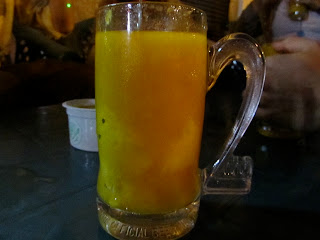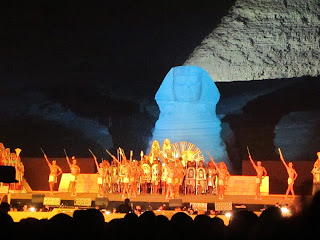Today was a really good day. In the afternoon our Amiyaa teacher (Egyptian Colloquial Arabic) decided to have class outside of the classroom. This is the same teacher I wrote about in my last post, the one who took me to get my key copied. As my classmates and I sat patiently waiting for class to begin, she swept in with a wave of infectious energy. "Yalla, yalla binat!" she called to us (Let's go, let's go girls!). We left the cold, totalitarian rooms of the language center and set out in the direction of the sea. Upon arriving on the Corniche, the long highway which runs alongside the Mediterranean from one end of Alexandria to the other, we were greeted by the fresh salt air in our hair and the ocean breeze reminding us that, despite the 101 degree day we had yesterday, the relief of winter weather is on its way. Our teacher walked to the side of the road and hailed a crowded minibus, something I have seen countless Egyptians do but have always been too intimidated to try myself. These minibuses, or microbuses, are really just old Volkswagon-style vans that can seat about 12 people, cost about 5 cents, and go most places along the Corniche and throughout Alexandria. To catch one, you stand on the side of the road and call out your destination to the driver as they speed by. If they have room and are heading in that direction, they slow down (but rarely come to a complete stop) to allow you to jump in. They are crowded, hot, and a little overwhelming, but they are very, really, and truly Egyptian.
Our adventure was only just beginning. Calling to the driver to pull over, we were deposited on the side of the road right across from a small ice cream shop. We sat with our teacher, Rawhia, and ate Egyptian ice cream and spoke Egyptian Arabic. I felt more connected to the culture than I have for a long time. Egyptian ice cream is closer to gelato than American ice cream in that it seems to feature more ice than cream. But Egyptian ice cream has a unique texture, a kind of chewiness that creates a whole new sensation in the mouth. Your teeth and tongue meet a sort of resistance as they try to melt the sticky sweet substance. It's not bad, but it takes some getting used to and I still think I prefer American ice cream. But then again, so do most Egyptians; they seem to have a strange obsession with Baskin Robbins.
 |
| My wonderful teacher, Rawhia |
After our sweet treat, Rawhia took us to the Abu al-Abbas al-Mursi mosque, which was one of the most beautiful mosques I have ever seen. An imposing figure in the skyline, it is intricately decorated both inside and out. Towering minarets and arching domes make it look like something straight out of the time of the Prophet. It was breathtaking architecture and design, but the religious emotion it is meant to instill was a bit lost on me. After the mosque we took a stroll down the street and stopped for some mango juice. It wasn't nearly as good as El Qobesi, but it was still pretty damn good. When my friend inquired about the possibility of purchasing a mango, tempted I'm sure by the pile of ripe fruit calling us in front of the juice shop, my teacher asked if we wanted to go to the biggest souk, or market, in Alexandria, that happened to be just around the corner. We replied with an enthusiastic affirmative. I was excited that I would have something new to share with you all that finally related to food again!
The energy and experience of an Egyptian souk is hard to describe and even harder to capture in pictures. But I will do my best:
The first sensation that hits you as you step onto the uneven, potholed street that is occupied by the souk is, admittedly, not a very pleasant one. The pungent smell of fish hits you full on in the face. Now, I love seafood. I love it raw, fried, grilled, baked, and just about any way you can think prepare it. But I have never overcome my urge to gag when I am confronted by a strong whiff of newly dead fish.
 |
| Tuna |
And Souk Midan? Filled with 'em.
 |
| Sardines |
Oh yeah, did I mention there were some not-even-quite-dead-yet ones too?
 |
| Still breathing, albeit laboriously |
But the souk is not just fish stands and before too long your nose adjusts to the smell of fish and begins picking up the other colorful fragrances of the crowded market. And crowded it is! A narrow street to begin with, the midan is lined on both sides by table after table, cart after cart, kiosk after kiosk of an incredible array of goods. All for prices that would allow the Little Matchgirl to live like a queen. That tuna pictured above? That little plaque says 10. It means 10 Egyptian pounds. Which means roughly 2 American dollars. Per kilo. Plus, the Little Matchgirl would have a hard time freezing to death in Egypt. Too bad Hans Christian Anderson wasn't Egyptian; how different her fate might have been.
The colors of the souk are vivid enough to blind you. Everywhere you look piles of vibrant fruits and vegetables create huge splotches of color along the street.
The fruits and vegetables aren't just colorful. They're fresh, fragrant, and sometimes they look so succulent you can't resist buying them. These pomegranates were practically singing a siren song to me:
 |
| Less than $1 per kilo |
But fear not, oh carnivores among you. The pescatarians and vegetarians are not the only diets catered to at this fabulous souk. Huge cuts of meat can be seen hanging from meat hooks that look straight out of Texas Chainsaw Massacre.
The meat has its own contribution to the colors and scents of the market place. The blood red intestines of a cow, ornamented by hibiscus flowers and a smoking bowl of fragrant incense,
the ivory white-pink gleam of a plucked chicken, surrounded by the flashy yellow of lemons, the eye catching green of raw okra, the startling orange of dried apricots and fresh persimmons,
and, of course, the extensive offerings of pigs feet, something that still looks like something out of an ancient sacrificial ritual to my American eyes.
There are huge grain sacks filled to the brim with wheats, barleys, pastas, and spices tempting me to plunge my hand in to feel that tickling sensation of thousands of little particles rubbing against my palms.
I'm also tempted to buy these grains and spices and even more so when I walk next door to see the possibilities they can offer when paired with butter, sugar, water, yeast, sesame seeds, and an assortment of fillings.
Further proof of the power of these grains is presented when a man passes right beside me carrying a huge tray piled with small baskets of hot, sweet, deep fried dough balls sprinkled with powdered sugar (a common Egyptian street food).
Another man carries his wares; swathed in ropes supporting his heavy contraption, he is a walking, talking juice stand. But Americans, and other foreign visitors, without "community immunity" must be careful with these kinds of offerings.
All five of your senses reach a state of heightened stimulation in this environment. Your nose is bombarded by the scent of animal carcasses, fruit fragrance, and the thickly sweet smoke of incense. Your eyes explore a kaleidoscope of colors. The air is loud with the hustle and bustle of people, the calls and shouts of the shop owners and street vendors, and, at certain parts of the day, the amplified call to prayer that rings out all over the city. The possibilities of flavors for your mouth to explore are endless. And you feel the presence of hundreds of Egyptians crowding you, the touch of the smooth pomegranates as you search for the perfect one, and occasionally the soft brush of a stray cat at your ankles.

Returning to my dorms after this adventure, exhausted and exhilarated by the excursion, I was met with some very good news. Our program directors have heard our complaints about our living situation and, after much campaigning and protesting on our parts, Dr. Mohammad (our resident director here in Egypt) is coming to Alexandria tomorrow to discuss alternative housing options for the remainder of the semester. I don't know for sure what this means yet, but we are all hoping to move out of the dorms and into apartments in the near future. This is an exciting prospect for many reasons, but for all of you the biggest reason is that this would mean we would be cooking our own meals. I had originally thought my second semester of blogging would be devoted to my own exploits in the Egyptian kitchen, but it looks like I might get a head start. Good thing too, I'm not sure I have the will power to stay away from Souk Midan and to keep my hands off the fresh fish and meats, ripe fruits and vegetables, and scrumptious baked goods. Who knows, maybe I'll even tackle the pig's feet. Not likely though.

















































